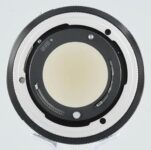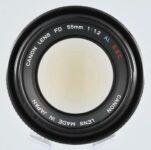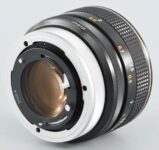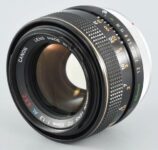Announced
Production status
Original name
System
Pros and cons
Genres or subjects of photography
Recommended slowest shutter speed when shooting static subjects handheld
Canon FD 55mm F/1.2 S.S.C. AL
Standard prime lens • Film era • Discontinued
Abbreviations
| FD | The lens is designed for Canon 35mm film SLR cameras with the Canon FD mount. |
| S.S.C. | Multi-layer Super Spectra coating is applied to the surfaces of lens elements. This anti-reflection coating increases light transmission, eliminates flare and ghosting, and maintains color consistence among all lens models. |
| AL | The lens incorporates aspherical elements. |
Model history
| ■Canon FD 55mm F/1.2 AL | A | 8 - 6 | 0.60m | ⌀58 | 1971 ● | |
| ■Canon FD 55mm F/1.2 S.S.C. AL | A | 8 - 6 | 0.60m | ⌀58 | 1973 ● | |
| ■Canon FD 55mm F/1.2 S.S.C. Aspherical | A | 8 - 6 | 0.60m | ⌀58 | 1975 ● | |
Specification


| Optical design: | |
| 55mm | |
| F/1.2 | |
| 35mm full frame | |
| Canon FD [42mm] | |
| 42.9° | |
| 8 elements in 6 groups | |
| 1 ASPH | |
| Floating element system | |
| Diaphragm mechanism: | |
Diaphragm type: | Automatic |
Aperture control: | Aperture ring (Manual settings + Auto Exposure setting) |
| 8 (eight) | |
| Focusing: | |
| 0.6m | |
| 1:9.1 | |
Focusing modes: | Manual focus only |
Manual focus control: | Focusing ring |
| Physical characteristics: | |
| 575g | |
| ⌀75.8×55mm | |
| Accessories: | |
| Screw-type 58mm | |
| BS-58 - Bayonet-type round | |
| Canon Extender FD 2X-B → 110mm F/2.4 |
Sources of data
- Canon FD lenses booklet (PUB. CE1001J) (December 1974).
- Canon FD interchangeable lenses instructions (PUB. A5368) (February 1974).
- Canon EF instructions (PUB. IE 1008P) (May 1976).
- Canon F-1 booklet (PUB. CE1017F) (December 1975).
- Canon F-1 booklet (PUB. NO5367Q) (September 1974).
- The pinnacle of optical perfection. Canon FD lenses booklet (PUB. CE1006F) (March 1973).
Manufacturer description #1
This is a large aperture standard lens in which aspherical lenses were applied. It is a perfect lens for delineation in photography at night with full aperture opening, in ordinary photography in daytime and at close distances as well. It eliminates flare to a negligible level, to give a picture image of fine contrast.
Manufacturer description #2
This is a large aperture standard lens using an aspherical surface, which provides highest image delineation even at full-aperture opening under dim light conditions. Additionally, this lens incorporates the Floating System which enables aberration-free shooting at close subject distance. Thus, a stabilized image is obtained through the entire focusing range. Therefore, the focused image through the viewfinder can be reproduced just as it is.
For further perfection, the Super Spectra Coating is applied to this lens to maintain clearness without ghosts.
Canon calls this lens the "perfect lens" because it provides sharpness under all photographic conditions.
From the Modern Photography magazine (November 1978)
With current ASA 400 color films pushable to E.I. 800 and fine quality 50mm f/1.4 lenses available from numerous camera manufacturers, who needs "super-speed" lenses? Haven't the f/1s and f/1.2s of the world been relegated to the role of extravagant, expensive, and bulky luxuries appealing mainly to snobbish gadgeteers and the handful of remaining "low light" photojournalists? Perhaps, to some extent, but like all great half truths, these rhetorical questions hint at only part of the story. After all, super-speed lenses have always been considered specialized tools and, surprisingly, their popularity has actually increased slightly as film speeds have gotten higher.
Twenty-five years ago, when 35mm SLRs were first beginning to become popular, the "normal" lens was usually a 50mm f/2.8 or a 58mm f/2. Soon afterward, the six element f/2s were opened up a bit to f/1.9 and even up to f/1.7. Lenses faster than these were considered to be "super-speed." It didn't take long for optical engineers to discover that the six-element designs they had been using for the f/2s were simply not good enough to produce satisfactory f/1.4s. Even with the newest high-index, exotic rare-earth optical glasses which were being developed by glass manufacturers around the world, optical engineers recognized that a radical change had to be made in the design of these early super-speed lenses.
Seven-element design
Among the original super-speeds was the famous 50mm f/0.95 Canon lens which featured seven glass elements, and pieces ground out of the rearmost elements so that the lens could fit into the Canon rangefinder cameras.
But the seven-element design method was not the only approach to getting sharp-imaging super-speed lenses. Leitz engineers decided to try their hand at a six-element, four-group 50mm f/1.2 lens for the Leica with a special non-spherical surface ground and polished into two of the elements.
Two types in use today
The situation today remains pretty much at this level: The two approaches are still being used. Most f/1.4 and faster lenses today are seven-element designs. A few are made with aspheric surfaces. Most interesting is the position of Leitz. The f/1.2 Noctilux with aspheric surfaces has recently been discontinued. So Leitz-Canada, under the engineering direction of Dr. Walther Mandler, developed a satisfactory f/1.0 using the latest rare-earth glasses and no aspherics. Canon offers their f/1.2 with aspheric surfaces.
In the Leitz-Canada 50mm f/1.0 Noctilux, there is considerable vignetting toward the corners. This is not an accident; it's deliberately built in to try to reduce the horrendous off-axis flare which appears in the image, and reduces contrast and resolution. The skew rays which pass through the outer parts of the elements on their way to the off-axis image often go badly off course. So, to avoid the resulting image quality loss, the designers purposely allow some aperture falloff for the extreme off-axis (edge) image points. We conclude that it's almost unavoidable when trying to engineer a super-speed lens with a reasonable number of glass elements.
Since the aspheric surface in the Canon 55mm f/1.2 lens is close to the diaphragm, off-axis rays pass through the lens more normally than they would for an aspheric surface at the back or in the front element. As a result, the beneficial effect of the aspheric surface applies to the off-axis light rays as well. We found that the off-axis image quality for the Canon lens at maximum aperture was not noticeably poorer than it was when the lens was stopped down to f/2. In other words whatever help the aspheric surface was designed to give could be seen over the entire image format.
What aberrations seemed to be the most important in the images formed by these lenses? First of all is the spherical aberration - both rim-ray (at the extreme edges of the lens at maximum aperture) and zonal, which occurs when the lens is closed down about one stop. A very careful balance must be made between the remaining rim-ray spherical and the residual zonal spherical aberrations so that the image quality will improve, not get worse, as the lens is stopped down. Nevertheless, with these super-speed lenses you do sacrifice a small amount of image sharpness and contrast when shooting at common apertures such as f/4 or f/5.6. However, by the time you reach apertures such as f/8 and f/1 1 superspeed lenses generally perform on par with their slower (f/1.7 or f/1.4) counterparts.
Lenses polished individually
But too much zonal spherical aberration can be a serious problem, too. If there is too much of it, a definite focus shift may be encountered when the lens is focused by observing the groundglass view with the lens wide open, and the picture is taken when the lens is stopped down, say, two full stops. Canon's use of the aspheric surface helps to get rid of this sticky problem in one complete (but radical) design change. The only problem which remains is that of the smoothness and accurate polishing which is required for the aspheric surface, and which has to be done one lens at a time in the optical shop. It is to Canon's credit that the 55mm f/1.2 does perform very well, and there are few if any aberrations attributable to irregularities in the aspheric surface.
Another problem is that of visible color due to spherical aberration. It may be that the optical engineer has designed the lens with a nice balance between the rim-ray and zonal spherical aberrations for green light. But, when we put blue and red light through the same lens, we might find that the blue rim-ray is over-corrected and results in a blue flare, while the red beam is undercorrected and there is red flare visible also. The overall result is a loss of color fidelity, particularly toward edges of the format and in the finer details of the image. This color variation of spherical aberration is one of the main reasons for the large number of lens elements required in the design of fast normal-focal-length lenses. This is also the main reason why so many lenses incorporate the familiar thick pairs of elements with a strong convex surface on one end and a similar strongly concave surface at the other. Look at the diagrams of some of the f/2 or faster normal lenses and you'll find these thick meniscus pairs easily.
Because a camera lens must produce a sharp image over a relatively wide angle of view, the off-axis (edge) image quality becomes a very important and limiting factor. It turns out to be easier to design a fast lens of longer than normal focal length because it does not have to cover as wide an angle of view. But the lens elements must be larger and the aberrations even more closely corrected or balanced.
In conclusion, if the extra speed is essential, today's super-speed lenses do not force us to accept noticeably poorer image quality either at wide, intermediate or stopped down apertures. If the lens is used primarily wide open, the aspheric Canon may be the best choice. In short, while super-speed lenses remain considerably more expensive and somewhat bulkier than their slower counterparts, their overall performance is now good enough to allow them to be purchased as replacements for, rather than additions to slower lenses of similar focal length.
Other standard prime lenses in the Canon FD system
Sorted by focal length and speed, in ascending order
| ■Canon FD mount (15) | |||||||||
| Canon FDn 50mm F/2 | A | 6 - 4 | 0.60m | ⌀52 | 1980 ● | ||||
| Canon FD 50mm F/1.8 | A | 6 - 4 | 0.60m | ⌀55 | 1971 ● | ||||
| Canon FD 50mm F/1.8 S.C. [I] | A | 6 - 4 | 0.60m | ⌀55 | 1973 ● | ||||
| Canon FD 50mm F/1.8 S.C. [II] | A | 6 - 4 | 0.60m | ⌀55 | 1976 ● | ||||
| Canon FDn 50mm F/1.8 | A | 6 - 4 | 0.60m | ⌀52 | 1979 ● | ||||
| Canon FD 50mm F/1.4 | A | 7 - 6 | 0.45m | ⌀55 | 1971 ● | ||||
| Canon FD 50mm F/1.4 S.S.C. [I] | A | 7 - 6 | 0.45m | ⌀55 | 1973 ● | ||||
| Canon FD 50mm F/1.4 S.S.C. [II] | A | 7 - 6 | 0.45m | ⌀55 | 1973 ● | ||||
| Canon FDn 50mm F/1.4 | A | 7 - 6 | 0.45m | ⌀52 | 1979 ● | ||||
| Canon FDn 50mm F/1.2 | A | 7 - 6 | 0.50m | ⌀52 | 1980 ● | ||||
| Canon FDn 50mm F/1.2L | A | 8 - 6 | 0.50m | ⌀52 | 1980 ● | ||||
| Canon FD 55mm F/1.2 | A | 7 - 5 | 0.60m | ⌀58 | 1971 ● | ||||
| Canon FD 55mm F/1.2 AL | A | 8 - 6 | 0.60m | ⌀58 | 1971 ● | ||||
| Canon FD 55mm F/1.2 S.S.C. | A | 7 - 5 | 0.60m | ⌀58 | 1973 ● | ||||
| Canon FD 55mm F/1.2 S.S.C. Aspherical | A | 8 - 6 | 0.60m | ⌀58 | 1975 ● | ||||
Lenses with similar focal length
| ■Interchangeable mount (1) | |||||||||
| Tamron 58mm F/1.2 [T] aka Taika Harigon 58mm F/1.2 | P | 8 - 6 | 1.8 ft. | 1960 ● | |||||






